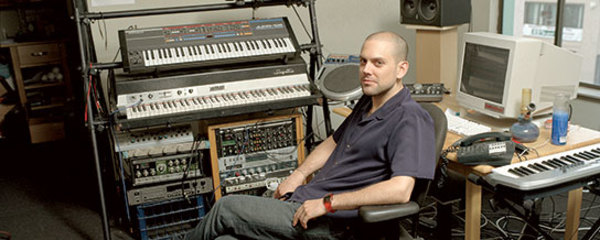Charles Spencer in the Studio
Charles Spencer’s studio–a few doors down from Jay J. Hernandez and Chris Lum’s famed Moulton […]
Charles Spencer in the Studio
Charles Spencer’s studio–a few doors down from Jay J. Hernandez and Chris Lum’s famed Moulton […]

Charles Spencer’s studio–a few doors down from Jay J. Hernandez and Chris Lum’s famed Moulton Street complex in the Polk Gulch district of San Francisco–also houses a medical marijuana dispensary. Out on the street, the pedestrian traffic turns from midday casual café dwellers to nighttime bar revelers and finally, around 1 a.m., to a myriad of multi-gendered sex workers. In this environment of change and extremes, Spencer and business partner Jessie Singer have carved out Loveslap!, a house label that is similar to New York’s King Street, issuing both blazing vocal numbers and deep instrumentals by Jaymz Nylon, Julius Papp, K. Hand, and Nick Santillan. Spencer has contributed 11 singles to the label and has additional releases on Grayhound, Frisky, and Society; he’s also remixed soulstress Goapele and chopped it up with rapper Capital A on Mantis Recordings. So what does this broken beat aficionado and disciple of classical composer Chopin use to get his hi-hats crisp and vocals resonant? Soft-spoken Spencer gave XLR8R the word on his studio essentials.
XLR8R: How did you get your start?
Charles Spencer: I grew up in Seattle and have studied classical piano since I was a kid. I moved to the Bay Area in ‘97 and was working in Silicon Valley doing network firewall security programming, but didn’t start making electronic music until later.
When did you set up your studio?
Loveslap! started renting office space in the [Moulton] building in 2000 and we set up the studio in 2001. I’m recording my own projects and doing engineering for other artists like Julius Papp.
Who are some artists seen regularly around the Moulton/Loveslap! complex?
Chris Lum, Jay-J, Miguel Migs, Ruben Mancias, and Kaskade. I just did some work with [singer] Kenny Bobien, which was pretty memorable.
What equipment is in the studio?
For keyboards, there’s a Juno 106, Fender Rhodes, and Studio Electronics SE-1–kind of like an analog Moog type of deck. I also use an Apple Macintosh G5, Mackie HR-824 monitors, Edirol keyboard controller, Hammerfall Audio Card, and the Sherman Filterbank. Software-wise I’m mostly using Ableton Live 4.0 and Propellerheads Reason. Previously I was using Logic [sequencing software], which was cool, but once I started using Live it was a lot easier to get things done. For vocals I record them to ProTools and bounce the file down and bring it into Live.
What is the best feature of Ableton Live?
Never having the music stop while you are developing a groove.
Any other software?
I use Spectrasonics Trilogy for bass and Audio Hijack Pro (which lets you record the sound output from any program), iTunes, DVDs, etcetera.
Does your computer set-up handle everything efficiently?
Yeah, I don’t really use a lot of plug-ins. I just make sure things are placed properly in the mix and EQ’d well.
What music is important to you?
I listened to a lot of jazz–Herbie Hancock, Oscar Peterson–and also classical music growing up. Now I’m pretty into the broken beat thing. I’m doing some tracks with Capital A on the broken beat tip that should be coming out eventually. I really wanted to get better at making house music before I moved on to other things. I feel like every style has a bunch of things you have to learn before you can work with it.
What other projects are you involved in?
I’m about halfway done on a downtempo album with [producer] Gregory DelPiero. I also work on tracks with Ruben Mancias–that stuff is a bit more mental.
Give some advice for young producers just starting out (something you had to learn the hard way).
Finish the track before getting too critical of it. It’s easy to move really slow if you always second guess yourself.
What’s you favorite recent cinema screening?
Super Size Me.

